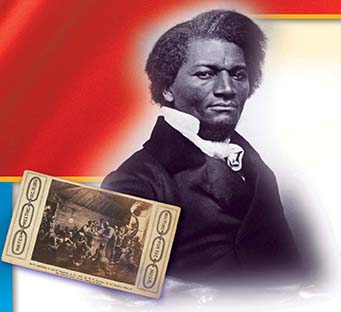SECTION 2: African Americans and the War

▲ Like the African Americans gathered in this postcard, Frederick Douglass celebrated the long-awaited Emancipation Proclamation
◄ Frederick Douglass
WITNESS HISTORY  AUDIO
AUDIO
A Memorable Day
Frederick Douglass, the foremost African American abolitionist, journalist, and orator of his time, traveled the United States and spoke out against slavery. In his autobiography, he described his reaction to the Emancipation Proclamation:
“The first of January, 1863, was a memorable day in the progress of American liberty and civilization. It was the turning-point in the conflict between freedom and slavery. A death blow was then given to the slave-holding rebellion. Until then the federal arm had been more than tolerant to that relic of barbarism…. We fought the rebellion, but not its cause. And now, on this day … the formal and solemn announcement was made that thereafter the government would be found on the side of emancipation. This proclamation changed everything.”
—Frederick Douglass, Life and Times of Frederick Douglass
Objectives
- Analyze why Lincoln decided to issue the Emancipation Proclamation and what it achieved.
- Assess the different roles that African Americans played in the Civil War.
Terms and People
- contraband
- Antietam
- Emancipation Proclamation
- Militia Act
- 54th Massachusetts Regiment
NoteTaking
Reading Skill: Identify Supporting Details As you read, use an outline to record details about African Americans during the war.
- The Push Toward Emancipation
- Enslaved African Americans Seek Refuge
- Enslaved people come under Union control
- Emancipation at Last
Why It Matters Despite Lincoln’s efforts to downplay the slavery issue, abolitionists kept up the pressure to end slavery. Soon, Lincoln himself recognized the need to include freedom for enslaved Americans among the goals of the war. His actions helped bring about the beginning of the end of slavery in the United States. At the same time, African American soldiers joined the fight for freedom. Section Focus Question: How did the Emancipation Proclamation and the efforts of African American soldiers affect the course of the war?
The Push Toward Emancipation
Pressures at home and abroad urged Lincoln to address the issue of slavery. Abolitionists such as Frederick Douglass and William Lloyd Garrison, as well as the thousands who supported them, were impatient with Lincoln’s policies. Another reason for Lincoln to act was that slavery was unpopular in Europe. Antislavery sentiment was one of the main reasons why Great Britain was reluctant to aid the Confederacy.
Enslaved African Americans Seek Refuge
On the battlefield, Union officers faced a dilemma: what to do with enslaved African Americans who came under their control. It was absurd, argued these officers, to return slaves to their owners. Early on, Union General Benjamin Butler had gathered hundreds of black refugees into his camps and set them to manual labor. He declared the fugitives




